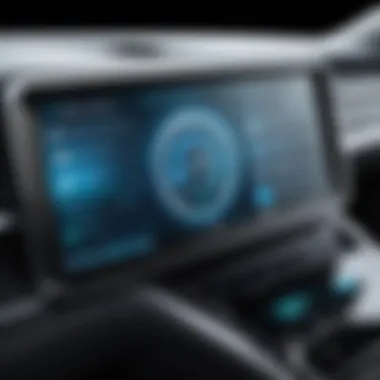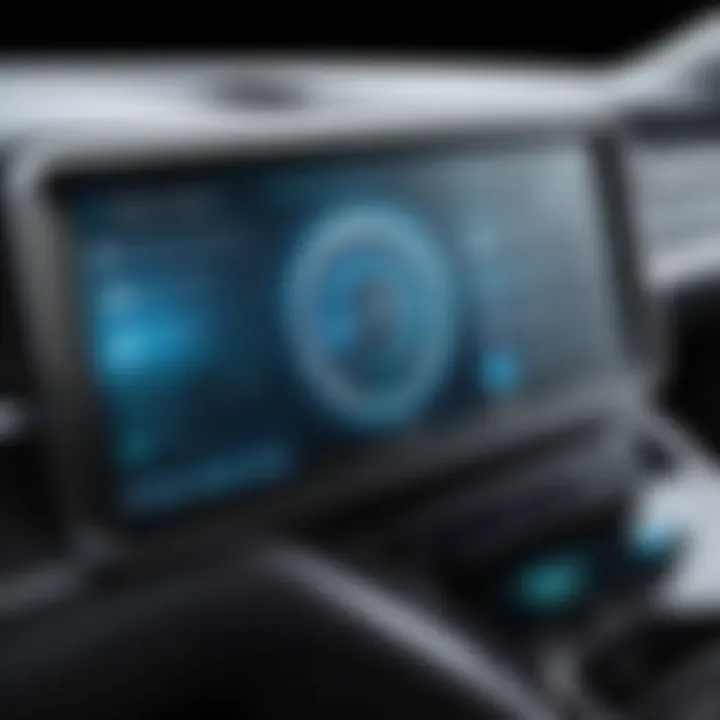Effective Strategies for Automating Driver Updates


Intro
In today's fast-paced technological landscape, keeping your device’s drivers up to date may feel like an endless game of catch-up. The momentum of updates can have significant implications for performance, security, and functionality. Whether you’re a casual user or a tech enthusiast, automating driver updates can ease your tech burdens. This article digs deep into effective strategies to ensure that your drivers are always current. Here, you’ll learn about various methods, from built-in operating system options to third-party software solutions while keeping best practices in mind.
Importance of Driver Updates
Outdated drivers can result in a host of problems, including system crashes, poor performance, and enhanced vulnerability to security threats. Think about it: your computer interacts with a myriad of components daily, from graphics cards to network adapters. Each of these components relies on drivers to function correctly, much like a conductor leading an orchestra. When drivers falter, the entire system can miss a beat.
Moreover, device manufacturers often release updated drivers to fix bugs, enhance performance, or improve compatibility with new applications. By automating this process, users can eliminate the hassle of manually checking for updates and potentially uncover hidden features or performance enhancements. Automating driver updates not only keeps your system running smoothly but also allows you to focus on what truly matters—using your technology effectively.
What to Expect
We aim to break down the complexities of automating driver updates into understandable sections. Here’s what’s ahead:
- A deep dive into various automation methods and tools
- Key considerations like compatibility and system requirements
- Tips for effective management of driver updates
By the end of this read, you will be armed with the knowledge needed to streamline your driver update process, ensuring your system remains robust and reliable, ready to take on whatever digital challenges arise.
Understanding Drivers and Their Importance
In the realm of computing, drivers act as the unsung heroes, operating seamlessly behind the scenes. Understanding this notion is crucial for any tech-savvy individual or enthusiast. Drivers essentially serve as translators between the operating system and the hardware, ensuring that commands issued by software are correctly executed by the hardware components.
What Are Device Drivers?
Device drivers are specialized software programs that enable the operating system to communicate effectively with hardware devices. When you install a printer, for instance, the corresponding driver acts like a middleman. It takes your print command from a word processor and relays it to the printer so that it can produce the hard copy. Without these drivers, your operating system wouldn't know how to instruct the hardware to act. There’s often a misconception that a computer can fully function without drivers, but that’s as far from the truth as saying a car can run without an engine.
The Role of Drivers in System Functionality
Drivers play a pivotal role in system functionality. They not only facilitate communication but also enhance performance and reliability. For example, graphics drivers optimize how images are rendered on your screen, affecting everything from gaming experiences to video playback. Similarly, audio drivers handle sound output, influencing clarity and surround sound capabilities. If the right drivers aren't in place, it’s like trying to mix oil and water—nothing blends well.
How Outdated Drivers Impact Performance
The impact of outdated drivers cannot be overstated. An outdated driver for your graphics card can lead to lower frame rates in games, causing your experience to be less than stellar. You might even face crashes or glitches. Likewise, an old network driver may slow down your internet connection, creating a frustrating bottleneck. In some cases, it can expose your system to security vulnerabilities, making timely driver updates a necessity rather than a suggestion.
"Regularly updating drivers is like regular maintenance for your car; it keeps everything running smoothly and efficiently."
Failure to keep drivers updated results in compromised performance and can hinder a device's longevity. Therefore, automating driver updates is not just beneficial—it's an essential practice for anyone looking to maintain their system's integrity and performance.
Identifying When to Update Drivers
Identifying when to update drivers is crucial for anyone looking to maintain a smooth-running system. Neglecting this task can lead to a myriad of performance issues, including slower boot times, erratic behavior of applications, and in severe cases, system crashes. A keen awareness of the telltale signs that a driver update is necessary helps prevent future headaches and enhances overall system reliability.
The benefits of promptly updating your drivers can’t be overstated. Primarily, updated drivers can improve system compatibility with the latest software, provide enhanced security features, and enable better performance from the hardware. The process of identifying when to conduct these updates involves understanding common indicators and utilizing diagnostic tools effectively.
Common Indicators for Driver Updates
Several obvious and subtle signs suggest that a driver update might be in order. The following points outline common indicators:
- Performance Issues: If your device frequently freezes, lags, or exhibits unusual behavior, it may be due to outdated or incompatible drivers.
- Error Messages: Unfamiliar error messages during device use can often pinpoint driver conflicts or issues requiring immediate attention.
- New Hardware or Software Installations: When installing a new operating system, hardware, or software, it’s prudent to check for driver updates to ensure compatibility.
- Increased Resource Usage: If the system suddenly starts using more CPU or memory without any apparent reason, that might indicate a driver problem.
- Hardware Not Recognized: If your system fails to recognize hardware like printers or graphics cards, often a driver update resolves this instantaneously.
Recognizing these signals not only saves time but also improves the longevity and user experience of your device.
Using Diagnostic Tools to Assess Driver Status
Integrating diagnostic tools into your routine can simplify the process of checking driver status. Most operating systems, such as Windows, provide built-in tools to help you stay on top of driver management. Here’s how you can make the most of them:
- Device Manager: This tool allows you to view all hardware connected to your computer along with their respective driver versions. Right-click on devices to access the update option.
- Event Viewer: This is more technical, but the Event Viewer logs critical errors that may relate to specific drivers. Monitoring it can guide you toward identifying problematic drivers quickly.
- Third-Party Software: Various third-party applications are designed specifically for scanning systems and reporting driver issues. However, choosing reliable software is essential to avoid potential risks associated with unknown tools.
- Windows Update: Regularly using Windows Update can streamline the process of staying informed about the latest driver releases.
Employing these diagnostic measures offers a proactive way to manage drivers and ensures your system runs optimally, ultimately safeguarding your investment in technology.
Automating Driver Updates in Windows


Keeping your system in tip-top shape is a fundamental part of any tech-savvy individual’s routine. The process of automating driver updates in Windows not only streamlines this task but also ensures that performance remains optimal without requiring manual intervention. In the fast-paced world of technology, having the latest updates is akin to having the edge in a race; it can prevent crashes, enhance security, and ultimately allow users to reap the full benefits of their hardware capabilities.
Built-in Windows Update Features
Windows, being the most widely used operating system, comes equipped with a multitude of built-in features designed to ease the burden of managing updates. The Windows Update feature serves as an automatic pipeline to ensure that drivers are kept fresh and reliable.
- Automatic Updates: When enabled, the system checks for new drivers and installs them without user involvement most of the time. This function can be set to run at specific intervals, often during times of low activity so as not to disrupt your tasks.
- Schedule Installation: Users can configure Windows Update to remind them of new updates, allowing for flexible installation times that work around busy schedules.
- Background Updates: Another appealing option is the ability of Windows to download updates in the background. This ensures that by the time you decide to reboot your PC, everything is ready to go.
By utilizing these features, users can leverage Windows Update not only for operating system patches but also for keeping drivers up to date—a powerful one-two punch for performance enhancement.
Configuring Device Manager for Automatic Updates
The Device Manager is a lesser-known but effective tool that gives users control over individual devices and their corresponding drivers. Configuring it for automatic updates can be a game-changer in the driver management arena.
- Accessing Device Manager: Right-click on the Start menu, select Device Manager. It’s like opening a treasure chest of hardware management out there!
- Driver Properties: Each device has properties that can be set to enable automatic updates. Checking the box for automatic driver updates can facilitate an easier update process when the system detects new driver offerings.
- Enumerate Your Devices: Regularly checking Device Manager lets you identify which devices are functioning smoothly and which might need an update.
It’s pressing to know that while Device Manager may not automatically capture every driver, especially those from third-party vendors, it still captures a good number of mainstream hardware drivers, making it a valid approach in the broader scope of driver management.
Using Windows PowerShell for Batch Updates
For those who venture into the realm of scripting and command-line interfaces, Windows PowerShell presents an advanced method for automating driver updates in bulk. This can be particularly useful for sistem administrators or tech enthusiasts managing multiple devices.
- Script Creation: Writing a simple script can automate the process effectively. The syntax may seem daunting at first, but once the concept clicks, it’s powerful. Here’s a basic example:
- Scheduled Tasks: PowerShell scripts can even be scheduled to run at defined intervals, which removes the need for manual execution entirely.
- Alerts and Logs: Implementing logging within scripts provides a way to monitor updates, allowing users to keep track of successful installations or any failures needing attention.
By wielding PowerShell, users embrace a level of flexibility that traditional GUI methods might not offer, taking a more hands-on approach tailored specifically to their needs.
Automating driver updates in Windows elevates the reliability of your system, akin to having a well-tuned engine that runs smoothly on a long journey.
In summary, integrating these automated strategies into your routine allows you to magically transform how updates are handled, keeping everything running like a well-oiled machine. Whether through built-in features, Device Manager configurations, or PowerShell scripting, each method has its merits and suits different user preferences. Therefore, assessing your individual needs is key to a seamless experience in keeping your Windows environment up to date.
Leveraging Third-Party Software Solutions
When it comes to updating drivers, third-party software solutions often enter the conversation as advantageous allies. These tools can simplify and enhance the experience of updating device drivers, making them a consideration worth delving into. They not only offer convenience but also bring a degree of functionality that native tools may lack.
Risks and benefits are intertwined in this discussion. On one hand, these applications can save hours of manual updates, which many tech enthusiasts would agree is a rare gift. On the other hand, users need to tread carefully, as not all solutions are created equal.
Overview of Popular Driver Update Tools
Several driver update tools have earned their stripes in the tech community, known for not only functionality but also overall effectiveness. Some noteworthy mentions include:
- Driver Booster: Recognized for its user-friendly interface and ability to keep thousands of drivers up to date.
- Snappy Driver Installer: An open-source option that is recommended for advanced users seeking flexibility.
- Driver Easy: Best known for its smooth automation features, allowing users to update multiple drivers with a single click.
Each of these tools comes with its own unique offerings which can cater to different needs depending on one’s technical know-how or specific requirements.
Selecting the Right Tool for Your Needs
Choosing the right driver update tool isn't just about brand popularity; context matters. One should consider a few key factors:
- User Interface: Is it intuitive or will you be banging your head against the wall?
- Customer Support: How accessible is help if you run into issues?
- Update Frequency: Does the tool keep pace with the latest driver releases?
- Compatibility: Will it work seamlessly with your operating system and hardware?
After weighing these aspects, aligning a tool with personal needs can lead to a much smoother driver update journey.
Potential Risks of Third-Party Software
While the allure of third-party driver updates is strong, it’s essential to be mindful of the potential pitfalls. Problems such as:
- Malware Risks: Some less reputable sources may bundle harmful software along with legitimate drivers.
- False Updates: Not all tools are accurate; they might flag drivers as needing updates when they're just fine.
- System Conflicts: Incompatible updates can lead to crashes or strange behavior in your system.
Thus, opting for reputable software and doing due diligence before downloading any applications is strongly recommended.


Remember: The saying, "you get what you pay for" often rings true in software solutions – reliability and security should never be sacrificed for a bargain.
Being aware of these risks allows users to navigate their options more effectively, bringing them closer to a safer and more efficient driver management strategy. So before putting the pedal to the metal, take some time to research and confirm that your choice stands the test of quality and performance.
Best Practices for Managing Driver Updates
In the realm of technology, especially concerning device performance, the management of driver updates often takes the backseat. However, adopting best practices for managing these updates can be pivotal. Not only does this ensure your system runs smoothly, but it also safeguards your devices against potential vulnerabilities. By following a few well-structured strategies, you can streamline the process, reduce risks, and enjoy a more stable computing environment.
Creating Restore Points Prior to Updates
Before diving into updates, it's advisable to create a restore point. This simple step acts as a safety net. In the unfortunate event that something goes awry with a new driver installation, a restore point allows you to revert your system back to its previous state without much hassle.
To create a restore point in Windows, follow these steps:
- Open the Control Panel and navigate to System and Security.
- Click on System and then select System Protection from the sidebar.
- In the System Properties window, under the System Protection tab, click Create.
- Input a description for the restore point and hit Create.
Having a restore point is like having an insurance policy. It's a small investment of time that can save countless hours of troubleshooting should issues arise.
Scheduling Regular Update Checks
Setting a schedule for regular update checks is another hallmark of effective driver management. A proactive approach beats a reactive one every time. By automating checks for updates, you can ensure that your drivers are up to date without even thinking about it.
Most operating systems have settings that allow users to schedule these updates:
- Windows Update can be configured to automatically check for updates weekly or monthly.
- Third-party software solutions also offer custom scheduling options that could work well with your specific setup.
"A stitch in time saves nine." Keeping your driver updates on a schedule lessens the chance of experiencing problems later on.
Maintaining Documentation of Driver Changes
Lastly, keeping track of driver changes might seem tedious but is highly beneficial. Documenting which drivers have been updated, when, and the outcomes of these updates helps in troubleshooting and planning future updates.
- Create an Excel spreadsheet or a simple text file where you log every update. Include details like the driver version, date of installation, and any noted issues.
- Regularly reviewing this documentation can provide insights into patterns of failure or success with certain updates.
By keeping detailed documentation, you equip yourself with knowledge that can aid in making informed decisions regarding your device management process. This is not only a hub of information but also a shield against chaotic troubleshooting sessions.
In encapsulating these best practices—of creating restore points, scheduling update checks, and maintaining documentation—you’re taking essential steps toward automating driver updates. Streamlining these tasks might seem minor, but they can go a long way in ensuring your systems not only function efficiently but also remain secure.
Troubleshooting Common Driver Update Issues
When it comes to managing device drivers, not everything runs smoothly. Troubleshooting common driver update issues is a vital part of keeping your system in tip-top shape. Whether you're running into failed updates, compatibility hiccups, or needing to revert to previous versions, addressing these problems effectively ensures your computer performs as expected. Facing these issues can be frustrating, but understanding the top challenges and their solutions can save time and headaches.
Dealing with Failed Updates
Failed updates can be a real thorn in the side. You think you’ve got everything under control, then bam! An error code pops up, leaving you scratching your head. This can happen due to various reasons, including network interruptions, corrupt files, or even conflicts between existing drivers.
To tackle failed updates:
- Check Internet Connection: Make sure your network is working smoothly. An unstable connection can cause download failures.
- Use Windows Troubleshooter: This built-in tool can help identify the issue quickly. You can access it through Settings > Update & Security > Troubleshoot.
- Delete Corrupt Driver Files: If outdated or corrupt drivers are causing the mess, you may need to go into Device Manager. Here’s how:
- Right-click on the Start button and select Device Manager.
- Locate the device with the problem, right-click it, and choose Uninstall Device. Restart your computer so Windows can attempt to reinstall the driver automatically.
Addressing these issues promptly keeps your system running smoothly, ensuring that everything from gaming to productivity software works without a hitch.
Resolving Compatibility Issues
Compatibility issues are another snag you'll want to watch out for. Sometimes, a newly installed driver might not play well with your current system setup. This can lead to software crashing, peripherals not responding, or even your whole system becoming unstable. Every driver isn’t a one-size-fits-all solution, and certain components can clash.
To overcome compatibility challenges:
- Check System Requirements: Always verify the driver’s specs before installing it. Look for minimum system requirements, which can usually be found on the manufacturer’s website.
- Rollback Drivers: If you notice problems after an update, rolling back to the previous version may solve the compatibility issue. Access Device Manager, find the device, right-click, and select Properties. Under the Driver tab, choose Roll Back Driver.
- Use Compatibility Mode: For drivers developed for older systems, running the installation in compatibility mode might help. Right-click the setup file, select Properties, go to the Compatibility tab, and choose your desired operating system from the dropdown.


Navigating compatibility issues can take some time, but it’s essential in preventing more significant system problems down the road.
Reverting to Previous Driver Versions
Sometimes, the best solution is to take a step back. Newer drivers aren't always better, despite what marketing might suggest. In fact, they can lead to instability or performance drops. That's where reverting to an earlier version comes into play.
To revert to a previous driver version:
- Open Device Manager: Right-click the Start button and open Device Manager.
- Locate Your Device: Find the device causing trouble and right-click it.
- Select Properties: Navigate to the Driver tab and click on Roll Back Driver.
- Follow the Prompts: Windows will guide you through the process to restore the driver to its former state.
This option saves you from unnecessary headaches and performance issues caused by unforeseen bugs in new updates. A careful approach to managing driver versions not only enhances system reliability but also grants you a tighter grip on your technology’s functionality.
"In the world of tech, sometimes less is more. Sometimes going back gives you exactly what you need to move forward comfortably."
By recognizing and addressing driver update issues directly, you set your system up for success, ensuring maximum performance and minimal disruptions. Remember that troubleshooting doesn’t just stop with fixing issues; it’s also about understanding the drivers you use and their role in your overall system operation.
Evaluating the Effectiveness of Updates
When it comes to keeping your system in top shape, evaluating the effectiveness of driver updates isn't just a matter of checking boxes. It's a critical process that can directly impact performance, stability, and functionality of your devices. This section unpacks the reasons behind monitoring updates, and details the strategies that can help you assess whether those updates have hit the mark.
Monitoring System Performance Post-Update
After committing to an update, the first step is to keep track of your system's performance. A driver update can significantly enhance or hinder performance, depending on the compatibility and the nature of the changes made. Therefore, you should observe how your system behaves after updates.
Key areas to monitor include:
- Boot times: Is your system booting up quicker or slower?
- Resource utilization: Are CPU and memory usage levels spiking abnormally?
- Device functionality: Are all devices working as intended? Any peripherals acting up?
Using tools like Task Manager or Resource Monitor in Windows can help you get a good picture of post-update performance. For those who prefer a more refined approach, third-party monitoring tools such as HWMonitor or MSI Afterburner might add some clarity.
It’s also worth noting that you should benchmark your system both before and after the update. This approach provides a clear, empirical comparison. Think of it like a health checkup for your device—it helps you notice any drop in health after something potentially beneficial was introduced.
Gathering User Feedback on Driver Performance
While technical metrics are crucial, the user experience often tells an equally compelling story. Gathering feedback from users who have recently updated their drivers can provide invaluable insights. After all, those who use the system daily can be the first to notice any quirks or improvements.
Here are some effective methods to collect feedback:
- Surveys: An anonymous survey can encourage users to share their thoughts without constraints. You may ask questions like: "How has your overall experience been since the update?" or "Have you noticed any new issues?"
- System forums and tech communities: Platforms like Reddit can serve as minefields of opinion and advice. Users share experiences, which may alert you to recurring issues that have sprung up after certain updates.
- Direct conversations: Sometimes a simple chat with colleagues or peers in the tech community can yield useful feedback.
“The squeaky wheel gets the grease.” Acknowledge any consistent feedback—be it positive or negative, and diversify your approach based on that. Sometimes, small patches can address larger issues, and quick iterations may be necessary to enhance user experience without delay.
Engaging with user feedback creates an inclusive system that values contributions and data from end-users, ensuring updates aren't just implemented, but also refined and improved post-launch. This can lead to more stable and reliable performance.
By keeping an eye on system performance and staying receptive to feedback, you can develop a clearer understanding of how effective your driver updates are. This not only aids in troubleshooting any immediate concerns but also sets the groundwork for future updates.
Ending and Future Considerations
As we reach the end of our exploration into the automation of driver updates, it’s vital to underline how this topic profoundly influences both system functionality and user experience. For many, the management of drivers can feel like navigating a labyrinth; however, it does not need to be a daunting task. The strategies outlined earlier encourage not just maintaining efficiency but also enhancing security in our devices.
The Evolving Landscape of Driver Management
The realm of driver management is constantly shifting, much like the sands in an hourglass. New technologies emerge, bringing along with them unique challenges and opportunities. Driver automation is no longer just a luxury; it's becoming a necessity. From traditional desktop computers to increasingly popular IoT devices, the landscape presents a diverse set of needs. As drivers continue to evolve, staying informed is crucial. Updates frequently introduce enhancements such as new features, improved performance, and, importantly, security patches.
Additionally, manufacturers are realizing the importance of these updates and are investing in more streamlined processes to deliver them. For instance, manufacturers are now rolling out firmware updates that can be applied seamlessly. Even so, users are encouraged to remain proactive about checking for updates. After all, a stitch in time saves nine.
Adapting Strategies for Different Operating Systems
Devices come with various operating systems, each having its own method for handling driver updates. It’s a mixed bag; a one-size-fits-all strategy simply won't cut it here. Take Windows, for example; it has robust built-in features for updating drivers but may lag behind in maintaining specific or legacy devices, requiring users to use a more hands-on approach with third-party solutions.
Meanwhile, macOS often takes the initiative by managing driver updates in the background, which can be a blessing. However, it doesn't hurt to regularly visit software update settings to see what’s been added or improved. On the other hand, Linux users typically rely on community-supported solutions. They may find themselves manually updating drivers often, introducing an element of unpredictability that can be both exciting and frustrating.
Bridging the Gap
To have a comprehensive strategy for driver updates, consider the following:
- Know Your OS: Familiarizing yourself with the specific needs of your operating system can help tailor your approach.
- Utilize Built-in Tools: Regardless of the OS, always make sure to leverage built-in tools first before relying on external applications.
- Schedule Regular Checks: Just like changing the oil in a car, regular checks can save a lot of headaches in the future.
- Stay Informed: Follow tech news, forums on Reddit, or even discussions on Facebook to keep up with the evolving technologies regarding driver updates.
In summary, the best approach isn’t static but needs to adapt to the changing environment of technology. Keeping a sharp eye on how each device receives updates and managing them effectively ultimately leads to an optimal performance and a more secure computing experience.



